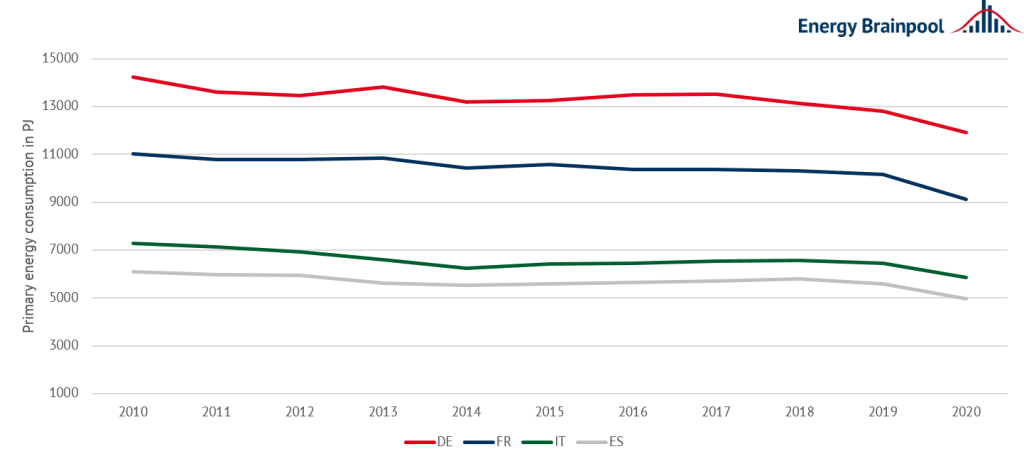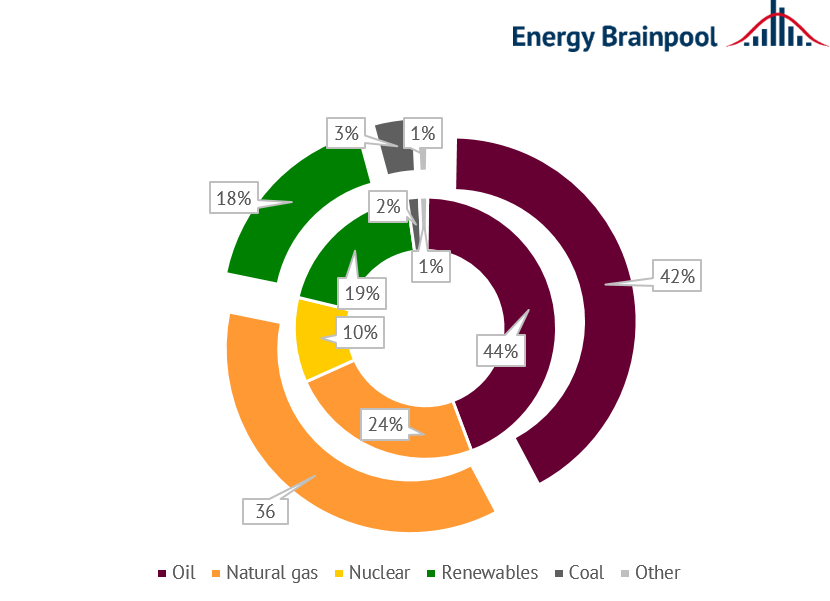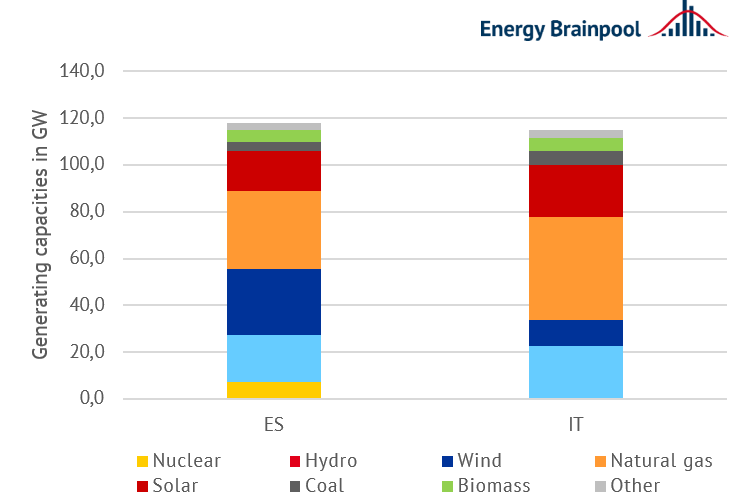After comparing the German and French energy systems, we now look at the number three and four in the EU: Italy and Spain. Both countries have a power plant fleet and electricity generation of similar size. However, Italy’s power generation is based on natural gas, while Spain generates larger shares of its electricity from wind power and nuclear power. A look at the figures below reveals similarities and differences.
Italy is the third largest country in the EU in terms of economic output and population, while Spain is the fourth largest. For this reason alone, Italy’s primary energy consumption is higher than that of Spain. However, the difference between the two countries is not as pronounced as between Germany and France. The comparison of the latter two can be found here.
Few differences in primary energy consumption
Primary energy consumption in Italy and Spain fell by 19 and 18 per cent respectively from 2010 to 2020. The economic slump caused by the Corona pandemic in 2020 was a key factor in this. Figure 1 depicts the change in primary energy consumption in the four countries between 2010 and 2020 (source: AGEB, IEA, ourworldindata.org).

Figure 1: change in primary energy consumption in Germany (DE), France (FR), Italy (IT) and Spain (ES) from 2010 to 2020 in PJ (source: Energy Brainpool, 2022).
A detailed look reveals that the shares of the individual energy sources in primary energy consumption in Italy and Spain are very similar. Both countries have a share of over 40 per cent for oil and each obtain just under 20 per cent of their primary energy from renewables. A comparison of the different primary energy sources of the two countries is shown in Figure 2 (source: ourworldindata.org).

Figure 2: shares of different energy sources in primary energy consumption in Spain (inner ring) and Italy (outer ring) in 2020, in per cent (source: Energy Brainpool, 2022).
Differences in 2020 were mainly in nuclear power, which accounts for 10 per cent of Spain’s energy consumption but plays no role in Italy. The use of gas, on the other hand, is more prevalent in Italy than in Spain, at 36 per cent. Coal as an energy source plays only a minor role in both countries.
Higher emissions in Italy
In 2020, the CO2-emissions (production-based) of the two countries were 304 million tons in Italy and 209 million tons in Spain (source: ourworldindata.org). Since peaking around 2005, emissions from fossil fuel combustion have fallen by almost 6o per cent in both countries. A major contributor to this was the Corona pandemic in 2020, but also the decline in coal-fired power generation in both countries, as well as the increased use of gas instead of oil in industrial processes. A per capita comparison of the two countries also shows the similarity: 5 tons per year in Italy and 4.5 tons per year in Spain.
The higher CO2 intensity of electricity generation in Italy has an impact here. While the average kWh in Spain emits only 166 gCO2, the larger share of generation in gas-fired power plants in Italy makes ist mark. There, the CO2 intensity of the electricity mix in 2021 was 224 gCO2 per kWh. This is where the difference between the two electricity systems becomes known.
Differences in power generation
The installed capacity of power plants in both countries is just over 115 GW. However, while Italy has 44 GW of gas-fired power plant capacity. Spain has only 33 GW installed (including combined heat and power plants). Italy had over 22 GW of solar capacity installed at the end of 2021, while Spain had only 17 GW connected to the grid. Last year, solar thermal power plants also accounted for 2.3 GW of Spain’s solar capacity. As one can see, the biggest difference between the two countries, however, occurs in wind power and the use of nuclear energy. Spain’s wind power plants have a capacity of just over 28 GW, while Italy has only 11 GW installed. Italy has no nuclear power plant capacity, while Spain has 7 GW of installed capacity. Figure 3 shows the power plant fleet of the two countries (source: RES, ENTSO-e, TERNA).

Figure 3: Spanish (ES) and Italian (IT) power generation capacities at the end of 2021 in GW (source: Energy Brainpool, 2022).
When comparing electricity generation, the difference becomes even clearer. Spain generated just under 260 TWh of electricity in 2021, while Italy generated just under 280 TWh (importing about 10 per cent of electricity consumption). However, about 55 per cent of Italy’s electricity production comes from natural gas. The dependence is particularly high here (see also our article on EU taxonomy). In Spain, the share of gas only stands at 28 per cent. Figure 4 illustrates the differences in electricity generation (source: RES, TERNA).

Figure 4: gross electricity generation in 2021 in Spain (ES) and Italy (IT) in TWh (source: Energy Brainpool, 2022).
Renewables generated over 40 per cent of electricity in both countries in 2021, with Spain having a higher share especially. This is due to a generation of 60 TWh from wind power compared to only 20 TWh in Italy.
Phasing out coal and nuclear power, more renewables
The dependence on fossil fuels is currently particularly evident due to the war in Ukraine and the possible halt in the supply of coal, oil and gas from Russia. Both Italy and Spain are planning to phase out coal generation. For example, the Spanish coal-fired power plants are to be shut down by 2030 at the latest, and the Italian ones by 2025 (source: Euractiv, IAI). However, Italy’s high dependence on Russian natural gas is currently upsetting these plans. An extension of the lifetime of coal-fired power plants is under discussion there (source: ansa).
With a 20 per cent share of electricity generation, nuclear power is still an important source of electricity in Spain. Nevertheless, the country wants to phase out the civilian use of nuclear power. According to Spain’s energy and climate plan, nuclear power plants are to be decommissioned in the period between 2027 to 2035 (source: EU Commission).
The generating capacity of renewable energies is to increase strongly in both countries. In Spain, large PV parks are already being financed and installed with the help of PPAs (source: PV Magazine). In Italy, too, more money is to flow into the expansion of renewables (source: Reuters).
Therefore, despite some differences in electricity generation, both countries are on the verge of phasing out conventional power plants and pushing forward the addition of renewables.
You are interested in the results of our last EU Energy Outlook of April 2022? Then we recommend our blogpost: Update: EU Energy Outlook 2050 – How will Europe evolve over the next 30 years?




What do you say on this subject? Discuss with us!